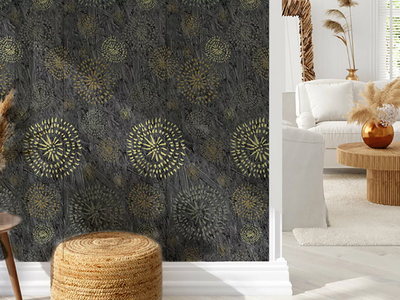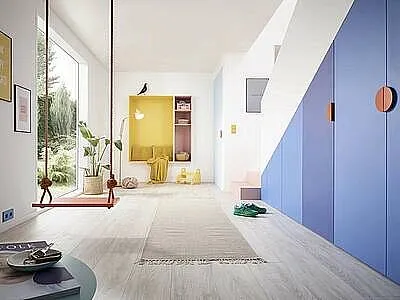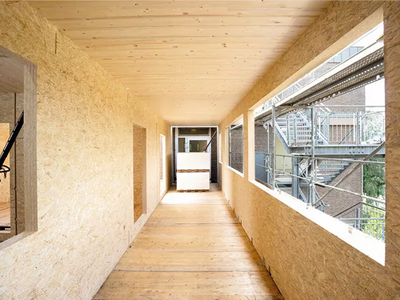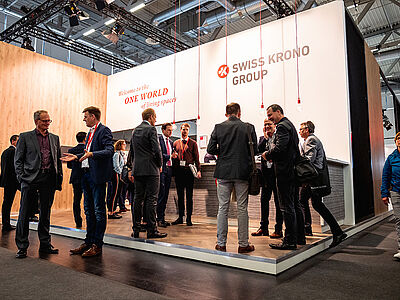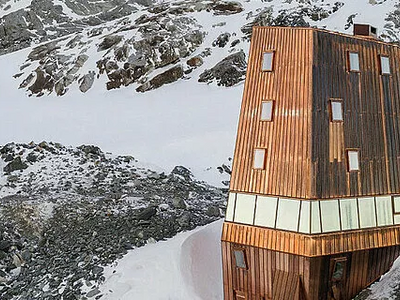OSB and Moisture – How Much Moisture Do OSB Boards Tolerate?
OSB – which stands for “oriented strand board” – was invented in the mid-1960s by technology pioneer Armin Elmendorf, who originally had interior finishing applications in mind. Today this popular engineered wood product has a vast range of uses. OSB’s high strength and ability to reinforce other structures, its relatively low mass and the fact that it halts penetration of water vapour all combine to make it a highly versatile, universal building material.
SWISS KRONO OSB excels across a diverse spectrum of applications: as a loadbearing timber construction material, as reinforcing planks, for making concrete formwork, as roof boards, for dry screed, for making shipping crates and furniture, and even for decorative purposes. The excellent technical properties and sealed surfaces of SWISS KRONO OSB make it superbly suited for modernisation and renovation projects as well as for erecting new, eco-friendly buildings. Yet it consists to 97% of wood, a natural raw material, so it seems logical that it ought to be impervious to moisture. As there is considerable disagreement about where and how OSB may be used, this article seeks to answer the questions “how much moisture does OSB tolerate?”, “where should which kinds of panel be used?” and “how can exposure to moisture be prevented?”
OSB Grades – Which Panel Is Suitable for What?
First of all, not every kind of OSB is suited for every application! To help us tell them apart, the European EN 300 standard defines various grades and use classes. Based on their mechanical performance and relative resistance to moisture, OSB panels are assigned to four different grades:
OSB/1
This covers general-purpose, non-loadbearing panels for interior fitments and furniture in dry conditions. This grade is not sold in Germany.
OSB/2
These panels are very strong and may therefore be used for loadbearing purposes where they will remain dry (utilisation class 1). It is rare for them to be used in construction, however.
OSB/3
Also for loadbearing purposes, but as these panels are made with water-resistant binders they may also be used in humid conditions (utilisation class 2).
OSB/4
This classification designates heavy-duty boards for use in both dry and humid conditions (utilisation class 2).
The rule of thumb is that panels of higher grades are stronger and more resistant to moisture. In addition, the standard defines various use classes based on dimensional changes, mechanical properties and performance:
1: Dry conditions
This class covers completed enclosed, heatable spaces. The average equilibrium moisture content is about 12% at an ambient temperature of 20°C, with relative humidity of 65% that is only exceeded for a few weeks each year.
2: Humid conditions
This class refers to roofed-over but open constructions which are not directly exposed to the elements. Solid wood components reach an average equilibrium moisture content of about 20% at an ambient temperature of 20°C and relative humidity of predominantly 85%. These values may only be exceeded during a few weeks each year, however. For engineered wood products, the value may not be greater than 18%, which is not due to stricter requirements but rather to the fact that engineered wood have a lower equilibrium moisture content under conditions that are otherwise the same.
3: Outdoor conditions
This class covers components that are directly exposed to the weather, resulting in an equilibrium moisture content greater than 20%. Examples are bridges, towers and similar structures.
It is important to take the climatic conditions at the installation site into account. For example, loadbearing boards used in the enclosures of indoor swimming pools can develop an equilibrium moisture content greater than 12% owing to the high relative humidity of the air, despite the fact that an enclosed and heated space is involved. This example therefore doesn’t match class 1. It is essential to make sure that conditions at the installation site will remain constant throughout the useful life of the loadbearing structure. If this is not the case, a higher use class should be assumed.
Engineered wood panels are described and classified by DIN EN 13986. They must belong to use class 3 for exterior use if they will be exposed to the weather. OSB/3 and OSB/4 boards must always be shielded from the weather. This means that, while they may definitely be used as structural building elements, they must be additionally protected by some kind of covering, such as a curtain wall. DIN 68800-2:2012-02 defines “protected from the weather” as meaning permanently and effectively covered or located beneath roofing or an overhang inside a line drawn inward and down at a 60% angle from the outer edge.
To prevent damage, it’s vital to make sure that at the time of installation, wood has a moisture content which is already very close to the equilibrium moisture content that will develop over time. Especially components intended for later use in class 1 or 2 applications must be protected during transport and installation to prevent them from being directly exposed to the elements and absorbing large amounts of moisture.
Prevention Starts During Transport and Storage
OSB must always be protected from exposure to substantial moisture during transport, storage and installation. It is also essential to transport and store panels lying flat, i.e. in a horizontal position. Boards may be briefly leaned against a structure at a 70° angle, but to prevent buckling and warping they must be stacked flat on a pallet or wooden spacers. Contact with the ground must be avoided, as rising moisture can also damage them.
Boards should ideally be stored in dry conditions beneath a roof. If it is unavoidable to temporarily store them outdoors, they must be covered with a watertight but water-vapour-permeable tarpaulin.
To sum up:
- Protect panels from the weather and high relative humidity.
- Prevent direct contact with the ground.
- Store horizontally in dry conditions under a roof.
- Leave outdoors only briefly, while covering them.
- Stack boards horizontally on pallets or wooden spacers (no more than 600mm apart).
- Always arrange spacers precisely above one another and parallel to the short sides of the boards.
- Let boards adjust to moisture conditions at the site for 48 to 72 hours before installation.
It doesn’t matter if boards get rained on once or twice. But if they do get wet, they should be allowed to dry thoroughly before installation, especially when they will be used as roofing. There shouldn’t be any water on them.
A moisture content of up to 21% is acceptable, if it can be demonstrated that this falls to no more than 18% within three months.
Unheated rooms or spaces below a floor or roof must be well-ventilated via openings that are equal in size to at least 1/150 of the floor area.
If boards have become wet or moist as a result of exposure to precipitation, flooding etc., the severity and duration of the induced swelling matter. Here too, the rule applies that their moisture content should not exceed 21%. If they have swollen too severely, you may want to consider purchasing new ones or contacting SWISS KRONO’s experts for advice.
Measuring Moisture Content
It’s best to use a professional wood moisture meter (also known as a hygrometer) to determine the moisture content of engineered wood products. These devices are routinely used to assess construction defects and check the suitability of firewood. There are various types. The most common ones have a port for connecting an external probe, which is placed on or driven into the product being measured, or two pointed electrode pins right on the instrument.
Some of them even let you select the wood type and/or the prevailing temperature and relative humidity. Prices can vary quite a bit depending on the manufacturer and included functionality, but start at around 30 euros. Alternatively, they can often also be borrowed or hired.
SWISS KRONO recommends using a moisture meter with an external hammer probe. Make sure to set it to pinewood and perform measurements at various places, as glue layers inside the material can distort the results.
SWISS KRONO OSB: Sanded on Both Sides or Water-Repellent
Unsanded SWISS KRONO OSB with water- and moisture-repellent ContiFinish® surfaces is explicitly intended for use in humid conditions. To make these products, wood strands are mixed with bonding resins and then pressed by flat metal platens into boards while heating them. This has the added effect of forming a thin, hydrophobic film of glue and wood resins on their surfaces: the so-called ContiFinish®, which reduces the risk of swelling and therefore allows brief contact with moisture.
However, even OSB boards with a water-repellent ContiFinish® should not be exposed to the weather or major sources of moisture such as condensation without any protection at all. Although the surfaces of the boards repel water, their edges are somewhat more vulnerable. Whereas moisture causes ordinary wooden boards to warp, OSB panels that become wet or moist tend to swell at their edges. However, a slightly swollen edge doesn’t mean that a board is damaged, and it will not normally be necessary to replace it.
Everything Tight?
Airtightness: An airtight layer prevents moist indoor air from penetrating into the structure by convection. This avoids moisture damage while reducing the need for ventilation, which in turn means less loss of heat. Where the airtight layer is penetrated by pipes and other installations, it must be tightly sealed around them. An excellent way to create an airtight layer is by attaching SWISS KRONO OSB on the inside.
Wind tightness: In contrast to airtightness, there is no standardised definition of wind tightness. A wind-tight layer merely serves to prevent cold outdoor air from cooling the insulation. This can be achieved with externally applied boards, for instance SWISS KRONO DP50 or WP50. There is no need to tape over the joints.

